Exploration of In vitro Phytochemical Screening, Cytotoxic, Anti-Arthritic and In vivo Analgesic Activities of Methanolic Extract of the Leaves of a Medicinal Plant
Joy C1, Mohammad Jamshedur R1, Mohin U2, Mobarak H1 Shahriyer MR1, Gula J1, Abdul M2 and Shahidul I1*
1Department of Pharmacy, University of Science and Technology Chittagong, Chattogram, Bangladesh
2Department of Pharmacy, International Islamic University, Chittagong, Chattogram, Bangladesh
Received Date: 29/07/2020; Published Date: 16/09/2020
*Corresponding author: Shahidul Islam, Assistant Professor, Department of Pharmacy, University of Science &Technology Chittagong, Bangladesh. E-mail: s_i_liton@yahoo.com
Abstract
The plants have power over therapeutic activities or apply beneficial pharmacological outcomes on the human body are usuallyassigned as “Medicinal Plants”. After screening of leavesof Leeaaequataunder the family of Vitaceae, it has beenfound positive results for carbohydrates, Flavonoids, Phenols, Tannins, Phytosterols and Saponins which are good markers for further research with this plants.The plant Leeaaequata has considerable Cytotoxic and Analgesic capacity which are very efficient.After investigation of antiarthritic activity of Leeaaequata it shows moderate protein inhibition which may bring success of plant research.A method, utilizing brine shrimp is proposed as a simple bioassay for natural product research. In case of my plant Leeaaequata it show mild cytotoxic effect.The significant pain reduction of Leeaaequata plant extracts might be due to the presence of analgesic principle acting with the prostaglandin pathways.
Keywords: Phytochemical Screening; Cytotoxic; Anti-Arthritic; Analgesic; Leeaaequata
Introduction
Plant is any one of the vast number of organisms within the biological kingdom Plantae; in general, these species are considered of limited motility and generally manufacture their own food. They include a host of familiar organisms including trees, forbs, shrubs, grasses, vines, ferns, and mosses. Conventionally the term plant implies a taxon with characteristics of multicellularity, cell structure with walls containing cellulose, and organisms capable of photosynthesis[ 1]. Although there are no apparent morphological characteristics in the medicinal plants growing with them, yet they possess some special qualities or virtues that make them medicinally important [2]. It has now been established that the plants which naturally synthesis and accumulate some secondary metabolites, like alkaloids, glycosides, tannins, volatiles oils and contain minerals and vitamins, possess medicinal properties [3]. Basically phytochemical assay of the plant extract should be done for the ensuring the presence of bioactive components of the corresponding plant extract [4]. It is the primary stage of plant of work. After screening of the phytochemicals of any plants, we can assume the next steps what should to do with plant extract [5]. The selected plant is also known as Kakjangha in Bengali. The plant Leeaaequatais traditionally used in the tribes areas for Astringent, Anthelmintic, Antipyretic, Alexiretic [6].It is also useful in Bronchitis, Anaesthesis of skin, Dyspepsia, Bilious fever, Leprosy, Itching, Tuberculous Ulcer [7]. It has now been established that the plants which naturally synthesis and accumulate some secondary metabolites, like alkaloids, glycosides, tannins, volatiles oils and contain minerals and vitamins, possess medicinal properties [8]. The aim of the present project work was find out the In-vitro Phytochemical screening, Cytotoxic, Anti-Arthritis and In-vivo Analgesic activities of the methanolic extract of Leeaaequata.Leaves of the plant Leeaaequatawere collected from KEPZ Hill tract area, KEPZ, Chittagong, Bangladesh in the month of January 2018.
Materials and Methods
Drugs and Chemicals
Sea salt non ionized NaCl, Methanol, Distill H2O, Formalin, Acetic Acid, DMSO, Diclofenac Na, Bovin Serum Albumin (BSA).
Animals
Mice weighing about 28-32 gm aged about 1.5 month were purchased from animal house of Department of Pharmacy, Jahangirnagar University, Savar, Dhaka, Bangladesh. All the animals were acclimatized to new environment for a period of one week. During the experiment period the animals were kept in a well ventilated animal house at 250C. They were supplied with standard pellets and fresh drinking water. All the mice were kept in cage and maintained with natural 12h light and dark cycle.
In-vitro Anti-Arthritic Activity of Leeaaequata [8]
0.05 ml various concentrations (800,400,200,100 µg/ml) of test dugs and standard drug diclofenac sodium (800,400,200,100 µg/ml) were taken respectively and 0.45 ml (0.5% w/v BSA) mixed.
The samples were incubated at 37°Cfor 20 minutes
The temperature was increased to keep the samples at 57°C for 3 minutes.
After cooling, add 2.5 ml of phosphate buffer to the above solutions.
The absorbance was measured using UV-Visible spectrophotometer at 416 nm.
The control represents 100% protein denaturation. The results were compared with diclofenac sodium. The percentage inhibition of protein denaturation can be calculated.
In-vivo Analgesic activity[9]
Procedure for Acetic Acid Induced Test
Administered extract solution (200 & 400 mg/kg) all the groups of mice orally
Observed the condition of mices till 30minutes
Then 0.6% Acetic acid solution is injected in intraperitonieally
Then counts the number of writhing of first 20 minutes.
Procedure for Formalin Induced Paw Licking Test
Administered extract solution (200 & 400 mg/kg) all the groups of mice orally
Observed the condition of mice till 30minutes
2.5% Formalin solution is injected into the mice paw
In early phase, first 5 minute observation & count the no. of licking
Then break for 10 minute
In late phase, last 15 minute observation & count the no. of licking.
In-vitro Cytotoxic Evaluation [10]
After 24 hours, the vials are observed using a magnifying glass and the number of survival nauplii in each vial were counted and recorded. From this data, the percentage of mortality of nauplii was calculated for each concentration of the sample. The median lethal concentration (LC50) of the test samples was calculated from straight line equation of graph. % of mortality can be calculated by using following equation:
% Mortality =
Where, N0 = Number of nauplii taken.
N1 = Number of nauplii dead.
Results and Discussion
Phytochemical Screening
The qualitative phytochemical screening was performed to ensure the presence or absence of secondary plant metabolites. In our investigation we have found positive results for carbohydrates, Alkaloids, Phytosterol, Phenol, Flavonoids, Tannins and Saponins. The result showed in (Table 1).
Table1: Phytochemical Screening of Leeaaequata.
(+)= Present ,(++)= Rapidly present
(-) = Absent
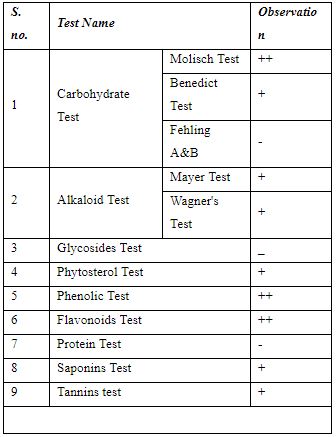
In-vitro Cytotoxic Activity
Test samples showed different mortality rate at differentconcentration. The mortality rate of brine shrimp napuliiwas found to be increased with the increase with the concentration of the sample. The median lethal concentration (LC50) was calculated. The LC50 values of methanol extract of Leea Aequatawas 87.82μg/ml (Table 2). So, it is evident that the methanol extract of Leeaaequatahave high cytotoxic activity.
Table 2: Effect of a.
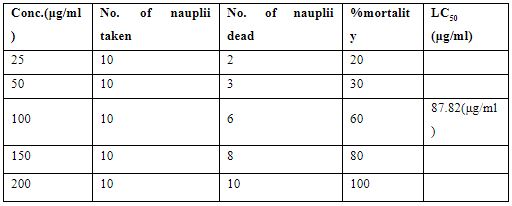
In-vitro Anti-arthritic Activity
The plant extract inhibited the protein denaturation by from a lowest 5% when conc. was 125µg/ml.To the highest % of inhibition was 35% when concentration was 1000 µg/ml as compared to standard drug diclofenac Na inhibited by 82% at 1000 µg/ml which is shown in (Table 3).
Table-3: Anti-arthritic activity of Leeaaequata.
In-VivoAnalgesicActivity:
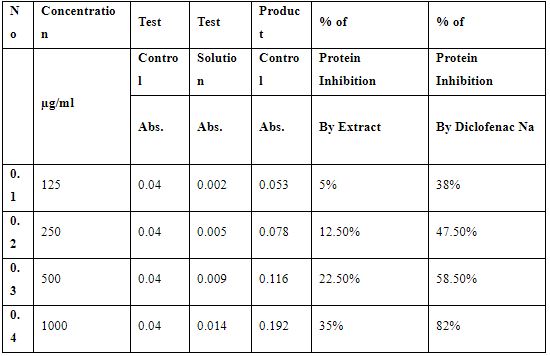
Acetic Acid Induced Writhing Test
In acetic acid induced writhing test, the methanol extract of leaves ofLeeaaequatasignificantly and dose dependently suppressed the frequency of acetic acid-induced writhing in mice after oral administration. At 200 mg/kg body weight, the extract showed 34.26writhing inhibition, at 400 mg/kg body weight, the extract showed 68.48 writhing inhibition which is shown in (Table 4). So, the plant extract showed analgesic activity at the dose of 400 mg/kg body weight was comparable to the standard drug Diclofenac sodium that inhibited70.79 writhing at the dose of 10 mg/kg body weight.
Table 4: Effect of Leeaaequata extract on acetic acid induced writhing response in mice.
Values are expressed as mean ± S.E.M. (n = 3).
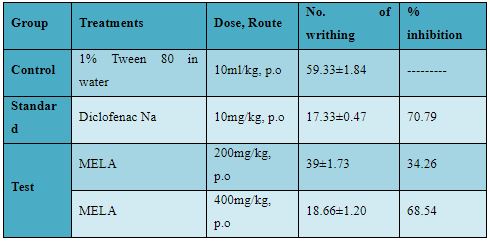
MELA=Methanol extract of–Leeaaequata
Formalin Induced Paw Licking Test
In formalin induced licking test, the methanol extract of Leeaaequatasignificantly and dose dependently suppressed the frequency of formalin-induced licking in mice after oral administration. At 200 mg/kg body weight, the extract showed67.51±4.09% licking time inhibition in early phase which is ,50.59±2.68%in late phase .At 400 mg/kg body weight, the extract showed50.74±1.71% licking time inhibition in early phase which 46.56±2.84% the late phase.(Table 5) So, the plant extract showed analgesic activity at the dose of 400 mg/kg body weight was comparable to the standard drug diclofenac sodium that inhibited 73.91±1.05% and 68.22±2.26% early and late phase respectively licking time at the dose of 10 mg/kg body weight.
Table 5: Effect of the methanol extract of Leeaaequata hind paw licking in the mice.
Formalin test in mice. Values are expressed as mean ± S.E.M., (n = 3)
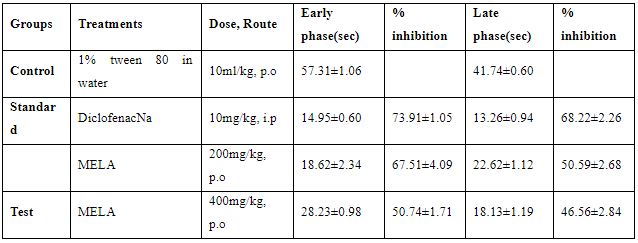
MELA=Methanol extract of Leeaaequata
Conclusion
In conclusion, this study evaluated significant phytochemical screening in-vitro Cytotoxic and Anti-Arthritis evaluation and in vivo Analgesic properties of the leaves of methanolic extract of Leeaaequata at different doses. The plant contains a lot of major groups of organic compounds.The study showed significant result in case of Anti-Arthritic study & Analgesic activity against both acetic acid & formalin induced pain in mice. According to study of the results and discussions of this plant extract it is proved that the plant might be a source of effective herbal drug & pain reducing agents. Although, All pharmacological profile were not performed for a single plant further improvements on such techniques and advancements in the procedure could be acquired through careful and systemic methods and hence requires advance new supplementary approaches. More precise studies are needed to elucidate their mechanism of actions for individual photochemical.
References:
- Bellah S, Islam M, Karim M, Rahaman M, Nasrin M, Rahman M, et al. Evaluation of cytotoxic, analgesic, antidiarrheal and phytochemical properties of Hygrophila spinosa (T. Anders) whole plant. Journal of basic and clinical physiology and pharmacology, 2017;28:185-190.
- Azwanida N. A review on the extraction methods use in medicinal plants, principle, strength and limitation. Med Aromat Plants, 2015;4:2167-0412. 1000196.
- Govindappa M, Poojashri M. Antimicrobial, antioxidant and in vitro anti-inflammatory activity of ethanol extract and active phytochemical screening of Wedelia trilobata (L.) Hitchc. Journal of pharmacognosy and phytotherapy. 2011;3:43-51.
- Hajhashemi V, Ghannadi A, Sharif B. Anti-inflammatory and analgesic properties of the leaf extracts and essential oil of Lavandula angustifolia Mill. Journal of ethnopharmacology, 2003;89:67-71.
- Wu W, Sun R. Toxicological studies on plant proteins: a review. Journal of Applied Toxicology, 2012;32:377-386.
- Md. JAT, Nazmul Q, Asif AM, Amran HM, Shams-Ud-Doha K, Apurba SA. Analgesic activity of extracts of the whole plant of Amaranthus spinosus linn. International Journal of Drug Development and Research, 3. 2011.
- Hossain S, Kader G, Nikkon F, Yeasmin T. Cytotoxicity of the rhizome of medicinal plants. Asian Pacific journal of tropical biomedicine, 2012;2:125-127.
- Meyer B, Ferrigni N, Putnam J, Jacobsen L, Nichols DJ, Mclaughlin JL. Brine shrimp: a convenient general bioassay for active plant constituents. Planta medica, 1982;45:31-34.
- Rahman H, Eswaraiah MC, Dutta A. In-vitro anti-inflammatory and anti-arthritic activity of Oryza sativa var. joha rice (an aromatic indigenous rice of assam). American-Eurasian J Agric Environ Sci. 2015;15:115-121.
- Eames AJ, Macdaniels LH. An introduction to plant anatomy. An introduction to plant anatomy. 1947.

